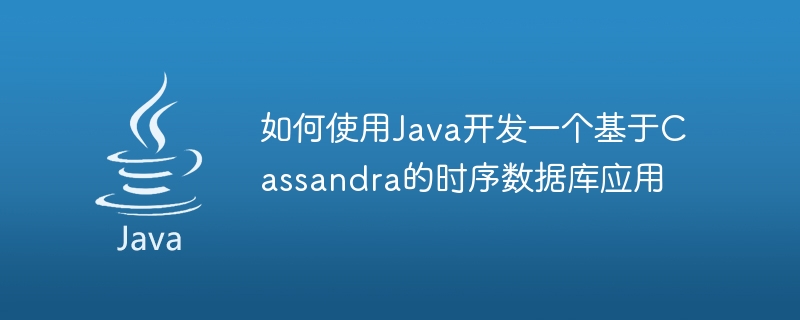

How to use Java to develop a Cassandra-based time series database application
Time series data refers to ordered data generated over time, such as sensor data, log data, etc. . With the development of the Internet of Things and big data, the demand for the storage and analysis of time series data is also increasing.
Cassandra is a highly scalable distributed database system with high performance and high availability, making it ideal for storing time series data. This article will introduce how to use Java to develop a Cassandra-based time series database application.
Step 1: Install and configure Cassandra
First you need to install and configure Cassandra. You can download the latest version of Cassandra from the official Cassandra website and install and configure it according to the guidelines of the official documentation.
After the installation is complete, start the Cassandra service.
Step 2: Create Cassandra table
In Cassandra, data is organized and stored in the form of tables. We need to create a table containing two columns: timestamp and value to store time series data.
You can use CQL (Cassandra Query Language) to create tables. Open CQL Shell (cqlsh) and use the following command to create a table:
CREATE KEYSPACE IF NOT EXISTS my_keyspace WITH REPLICATION = {'class': 'SimpleStrategy', 'replication_factor': 1};
USE my_keyspace;
CREATE TABLE IF NOT EXISTS time_series_data (
sensor_id UUID,
timestamp TIMESTAMP,
value DOUBLE,
PRIMARY KEY (sensor_id, timestamp)
)
WITH CLUSTERING ORDER BY (timestamp DESC); The above command creates a keyspace named my_keyspace and creates a keyspace named time_series_data# in it. ## table. sensor_id is the unique identifier of the sensor, timestamp is the timestamp of the data point, and value is the value of the data point. PRIMARY KEY specifies the primary key of the table, where sensor_id is used as the partition key, timestamp is used as the clustering key, and is sorted in descending order.
com.datastax.oss java-driver-core 4.13.1
pom.xml file and update the project dependencies.
import com.datastax.oss.driver.api.core.CqlSession;
import com.datastax.oss.driver.api.core.CqlSessionBuilder;
public class CassandraTimeSeriesApp {
public static void main(String[] args) {
try (CqlSession session = new CqlSessionBuilder().build()) {
// 建立Cassandra会话
// 插入数据
session.execute("INSERT INTO my_keyspace.time_series_data (sensor_id, timestamp, value) VALUES (?, ?, ?)",
UUID.randomUUID(), Instant.now(), 25.0);
// 查询数据
ResultSet resultSet = session.execute("SELECT * FROM my_keyspace.time_series_data WHERE sensor_id=? LIMIT 10",
UUID.randomUUID());
// 处理查询结果
for (Row row : resultSet) {
UUID sensorId = row.getUuid("sensor_id");
Instant timestamp = row.getInstant("timestamp");
double value = row.getDouble("value");
// 处理数据
System.out.printf("sensorId=%s, timestamp=%s, value=%f%n", sensorId, timestamp, value);
}
}
}
}CqlSession). Then, insert data into the table by executing CQL statements, and query the data using CQL query statements. Finally, iterate over the query results and process the data.
The above is the detailed content of How to use Java to develop a Cassandra-based time series database application. For more information, please follow other related articles on the PHP Chinese website!
